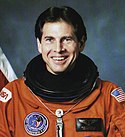Samuel Thornton Durrance
| Samuel Thornton Durrance | |
|---|---|
 | |
| Astronaut NASA | |
| Datum narození | 17. září 1943 |
| Místo narození | Tallahassee |
| Datum úmrtí | 5. května 2023 (ve věku 79 let) |
| Místo úmrtí | Viera |
| Předchozí zaměstnání | vědec |
| Čas ve vesmíru | 25 dní, 14 hodin a 13 minut |
| Kosmonaut od | 1984 |
| Mise | STS-35, STS-67 |
| Znaky misí | |
| Kosmonaut do | 1996 |
| Některá data mohou pocházet z datové položky. | |
Samuel Thornton Durrance (17. září 1943 Tallahassee, Florida, USA – 5. května 2023 Viera, Florida)[1] byl americký vědec a astronaut. Ve vesmíru byl dvakrát.
Život
Studium a zaměstnání
V roce 1974 ukončil vysokoškolská studia na California State University v oboru fyziky, poté vystudoval astrofyziku a geofyziku na University of Colorado at Boulder. V roce 1980 získal titul PhD. Používal přezdívku Sam.
Byl ženatý s Rebeccou Tuggleovou a měli spolu dvě děti, Benjamina a Susan.
Z NASA odešel v roce 1996 do soukromého sektoru.
Lety do vesmíru
Na oběžnou dráhu se v raketoplánech dostal dvakrát a ve vesmíru strávil 25 dní, 14 hodin a 13 minut. V posádce zastával post letového specialisty. Byl 243. člověkem ve vesmíru.
- STS-35, Columbia (2. prosince 1990 – 10. prosince 1990)
- STS-67, Endeavour (2. března 1995 – 18. března 1995)
Odkazy
Reference
- ↑ Samuel Durrance, astronaut who flew with telescope he built, dies at 79. collectSPACE.com [online]. [cit. 2023-05-06]. Dostupné online.
Externí odkazy
 Obrázky, zvuky či videa k tématu Samuel Thornton Durrance na Wikimedia Commons
Obrázky, zvuky či videa k tématu Samuel Thornton Durrance na Wikimedia Commons - Na webu Space
- Na webu MEK-Kosmo
Média použitá na této stránce
STS-35 Mission Insignia
portrait astronaut Samuel Durrance
STS-67 Mission Insignia


